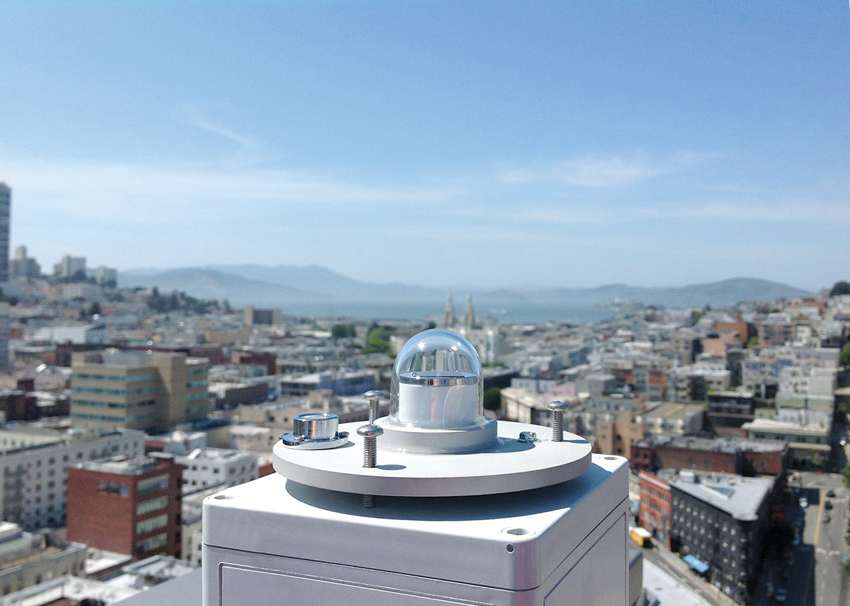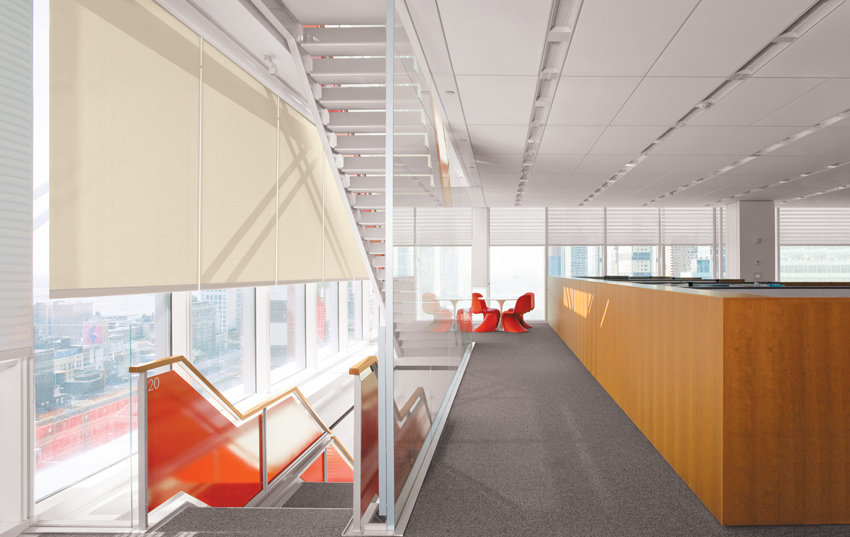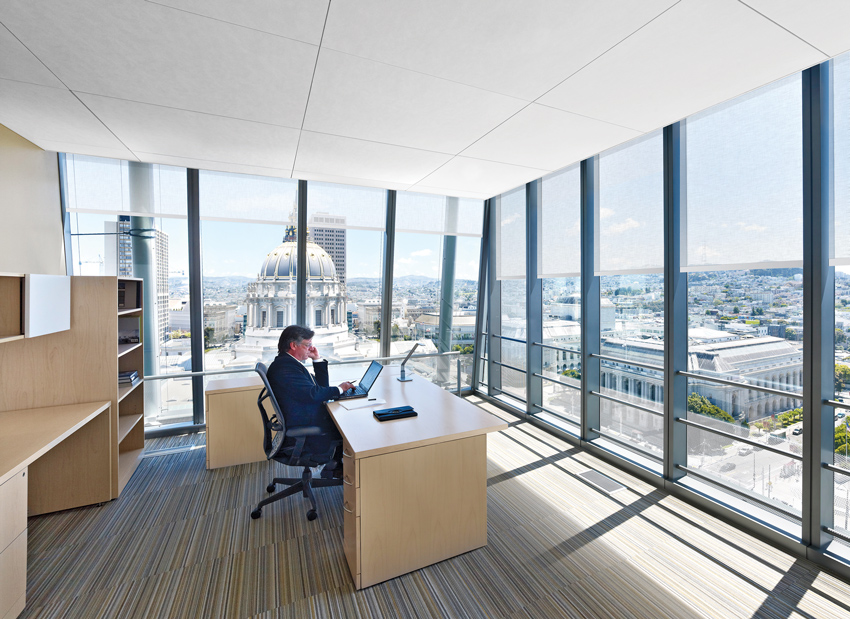Advancing the Daylighting Discussion
Introducing Automated Shading Systems
An automated shading system predicts, monitors, and responds to the unique, daily microclimate surrounding the building. These systems are comprised of motorized woven solar fabrics, advanced daylighting software, roof-mounted solar radiometers that monitor sky conditions in real time, exterior-mounted photometers that monitor sky brightness, and minimal interior-mounted photosensors that monitor for the presence of direct sunlight and brightness that may disrupt the visual environment. The system applies an advanced algorithm that considers the changing position of the sun in relation to the building and the changing solar angles at each window, along with the real-time climatic information detected by the sensors, to determine the optimal position of every shade throughout the day. The solar fabric is raised and lowered accordingly to prevent glare and solar heat gain from entering an interior space and allow soft, usable daylight into the interior. It is important to note that automation systems can be scalable and range from a sensor and a few motors to floors to whole buildings or an entire campus. Not all features are present on all systems, sensors have different design intent, and specifications and a commissioning strategy will vary accordingly.
Automated shading systems can be incorporated into the interior of a building, sometimes the exterior, or in an environmental wall, between panes of glass with sealed or ventilated air cavities to enable heat recovery, heat rejection, daylighting, and natural ventilation. Of the three options, automated interior shading systems offer a simpler, often lower-cost solution that can be applied to new construction as well as major renovations and tenant improvements.
These systems enable a designer to incorporate more glass and clearer glass into their designs, and provide occupants with a constant connection to the outdoors, without subjecting interiors to harsh glare and solar heat gain. When compared with some of the other available daylight control systems, shading systems are unique in their ability to deploy a woven solar shade, to block direct sunlight, and yet still provide a view to the outdoors. The woven nature of the solar shade enables people to see beyond the shade, unlike blinds or louvered solutions that provide a visual obstruction when in position.
By effectively managing solar heat gain, automated shading systems also create tremendous HVAC energy savings. The deployed solar shades reflect or absorb much of the heat energy present in direct sunlight. For the thermal energy that remains inside the building envelope, shades tend to keep that energy at the perimeter rather than letting it penetrate deeper into the interior. The reflected heat can pass back through the glazing and into the outdoors, or it can become trapped between the shade and the pane of glass. The solar fabric that absorbs the solar radiation can heat up as well. While the solar shade effectively contains much of the solar heat at the window, the return air vent located in the pocket above the window, in which the solar shade is also installed, helps to get this solar-heated air out of the building. The heat trapped at the window pane or absorbed by the fabric moves up into the pocket and is evacuated through the return air vent, never entering the interior space. In an application without pockets, the mechanical engineer can position the air return at the window wall to collect heat passing beyond the shade.

Photo courtesy of MechoSystems
Solar radiometers are mounted on the roof to continuously monitor sky conditions and enable the shading system to adjust to cloudy or clear days accordingly.
Daylighting Terminology and Metrics
The technology used by automated shading systems and the technology used to evaluate the effectiveness of automated shading systems have advanced dramatically since 1974. As it has become possible to achieve better daylight management in the built environment, and prove it, both quantitatively and qualitatively, the discussion around how daylight can be used in a space and the metrics that help to determine whether the incorporation of daylight in the design has been successful have also advanced.

Photo courtesy of MechoSystems/PDK Commercial Photographers
Daylighting goals at The New York Times Building included maximizing the natural light in the space, maximizing occupant connectivity with the outdoors, avoiding direct solar radiation on occupants, and maintaining a glare-free environment.
Daylighting
Daylighting refers to the practice of purposefully bringing daylight into a building. There are a number of important objectives that can be achieved with good daylighting design, from reducing the electrical use of the lighting system to improving the mood and productivity of building occupants. However, not all daylight is equally equipped to support these goals. In certain conditions, daylight can cause glare, discomfort, and solar heat gain.
Daylight can enter a space in many forms. It can be a direct beam from the sun, diffused through a sky light, or reflected off of an exterior or interior surface. Daylighting practices attempt to use the daylight available on a project to effectively satisfy specific design goals and realize the many potential benefits of daylight inclusion, while protecting interiors from the negative effects of glare and solar heat gain.
Daylight Harvesting
Daylight harvesting, sometimes referred to as daylight integration, refers to the practice of coordinating the presence of daylight and electric light in a space so that electric light levels are reduced (and, in some instances, turned off) when sufficient daylight is available, saving energy throughout the day.
The potential energy savings from daylight harvesting is substantial. The 2011 Heshong Mahone Group study titled “Office Daylighting Potential” found that daylight harvesting could reduce the energy used for electric lighting in California’s existing office buildings by 17 percent. Today, estimates of the energy savings that can be realized by daylight harvesting have increased considerably, pegging the potential reduction at more than 30 percent. In the Daylighting section of the Whole Building Design Guide (www.wbdg.org), Gregg Ander, FAIA, writes “for many institutional and commercial buildings, total energy costs can be reduced by as much as one-third through the optimal integration of daylighting strategies.”
Daylight Autonomy
Daylight autonomy is a more recently coined daylighting term, and it describes a daylighting objective where designers hope to do more than coordinate the presence of electric light and daylight—they want to eliminate the need for electric light altogether, for as much space as possible, for as much of the day as possible. Although relatively new, daylight autonomy goals are already filtering into green building initiatives, such as the Leadership in Energy and Environmental Design (LEED) green building rating system, and new metrics have been designed to measure the daylight autonomy that a space is able to achieve.

Photo courtesy of MechoSystems/Bruce Damonte
Daylight autonomy describes the design objectives where designers hope to eliminate the need for electric light altogether, for as much space as possible, for as much of the day as possible.
Daylighting Metrics
Daylighting metrics help quantify the presence of daylight in a space and aid the design community in determining whether certain daylighting goals have been reached. For example, daylight factor (DF) is one of the most traditional metrics used to measure daylight illuminance in a building. It identifies the percentage of available daylight that has been allowed into the interior at a given time by comparing the level of daylight available, as defined by the International Commission on Illumination (CIE) in the CIE standard overcast sky, at a specific time, with the amount of horizontal illuminance that occurs at a specific interior point at the same specific time.
While the use of DF predates the widespread adoption of electric lights, and it was used more recently in previous versions of the LEED green building rating system to set a target level of daylight incorporation, the metric has some major limitations. The Recommended Practice for Daylighting Buildings (RP-5-13), published by the Illuminating Engineering Society (IES), identifies the consideration of only the overcast sky condition as a weakness, but also cites that the metric “does not include contributions from direct and reflected sunlight, and does not distinguish between performance due to latitude, climate type, facade orientation, or time or day or year.”
Recently, new daylighting metrics have emerged that consider the annual presence of the sun in a space instead of the amount of daylight present at one specific time. These annual metrics provide designers with a clearer picture of how daylight will interact with the building, and building occupants, over time and can be used as powerful tools in helping designers create spaces that are free from glare and solar heat gain, while realizing impressive energy savings.
Annual Sunlight Exposure (ASE)
The annual sunlight exposure (ASE) metric helps designers to identify whether their project spaces will be penetrated by enough direct and intense sunlight throughout the year to warrant a tweak in the design or a daylighting management system, such as automated solar shades. The ASE refers to the total number of hours in a year that a specific point of interest receives direct sunlight at a level that exceeds a certain value. The RP-5-13 states, “The objective of ASE is to indicate the risk of visual discomfort from direct sunlight and/or the likelihood that window blinds may be deployed or other action taken to avoid discomfort from direct beam sunlight.”
As Matthew Tanteri, design principal of Tanteri Associates, Austin, Texas, and a member of a collaborative alliance focused on daylighting and sustainability with HLB Lighting Design, Austin, Texas, explains, “The ASE metric provides a litmus test that indicates whether or not a building, as it is designed, will need some type of shading to protect the occupant from the amount and intensity of direct sunlight to which he or she will be exposed throughout the year. The test looks for the percentage of space that experiences more than 1,000 lux of daylight for more than 250 hours annually before the deployment of any operable blinds or shades. If that percentage is over 10 percent, based on the metric’s supporting research, it starts to indicate that the building will need a shading system to ensure the visual comfort of the occupants.”
Daylight Autonomy (DA)
The daylight autonomy (DA) metric measures the percentage of the occupied time throughout the year that a target level of illuminance is met or exceeded by daylight alone. The written notation of the DA metric includes the target illuminance. For example, if the target illuminance on the work plane in an office space was 300 lux (30 fc), the DA metric would be written as DA300. If the space is able to achieve an illuminance level of 300 lux at the work plane for 50 percent of the day, then the DA300 value for the space is 50 percent.
Spatial Daylight Autonomy (sDA)
The spatial daylight autonomy (sDA) metric extends the application of the DA metric and provides the percent of the area in a room or building where a given daylight autonomy value is achieved. For example, if the daylight autonomy targets are 300 lux (30 fc) in a space for 50 percent of the workday, the sDA metric is written as sDA300, 50 percent and the sDA value would represent the percentage of the space in the building where daylight alone provided 300 lux (30 fc) for half of the workday. A larger sDA value indicates that more of the building can be lit, for at least part of the day, by daylight exclusively.
Where LEED once employed the daylight factor to set target levels of daylight incorporation, LEED v4 now recognizes the sDA metric and awards points based on how much of a building is able to achieve predefined daylight autonomy levels.
“The sDA metric was a breakthrough for many reasons, it’s co-metric relationship with ASE probably being one of its more unique aspects,” explains Tanteri. “It replaced daylight factor, which everyone knew was flawed once applied to anything other than an overcast sky condition. But sDA was developed before there was a way to calculate it. That says a lot about how fast the industry is moving. Now that we are applying these new metrics, we are learning lessons about what works and what doesn’t with the new designs and new technologies they are inspiring. The industry is in a state of constant evaluation and re-evaluation.”
It is important to note that not all daylighting metrics are applicable to every project. As Jim Ashmore, IES, explains, “The designer will need to consider the unique project and project goals to determine which metric or combination of metrics will provide the best snapshot of daylighting performance for that specific space.”









